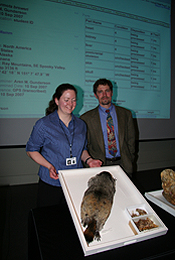Alaska marmot marks museum milestone
Alaska marmot marks museum milestone
Submitted by Kerynn Fisher
Phone: 907-474-6941
04/23/08

An Alaska marmot recently made history at the University of Alaska Museum of the North by becoming the 100,000th mammal specimen in the museum’s research collections. A pygmy sperm whale is the museum’s 100,001st.
"These milestone specimens really speak to the value of the collection as a resource for scientists and to the collection’s potential in future research efforts," says museum mammal curator Link Olson.
The Alaska marmot is one of the least-studied mammals in North America and one of three mammals endemic to mainland Alaska; the Glacier Bay water shrew and Alaska hare are the other two endemic species. Because the Alaska marmot’s range is limited to alpine areas north of the Yukon River, it may be particularly sensitive to climate change. The milestone specimen, UAM 100000, is preserved in the collection as a skull, postcranial skeleton and skin, as well as frozen tissue samples from the kidney, liver, heart and spleen. The pygmy whale specimen, UAM 100001, was found dead on the beach near Yakutat, expanding the species’ known North American range by more than 800 miles.
The Alaska marmot and pygmy sperm whale specimens join 99,999 other specimens in the museum’s collections, primarily small mammals collected since the mid-1950s. The collection includes exceptional holdings of northern carnivores and marine mammals, as well as extensive series of most other Beringean mammals. Recent collecting activities in Southeast Asia and other locales have expanded the geographic and taxonomic scope of the collection beyond Alaska. For example, the museum now holds the world’s largest collection of Cambodian mammals.
The collection serves as a valuable resource for researchers studying evolution, species distribution, response to climate change, genetics, contaminants and other current issues. Since 1993, the museum has loaned 33,000 mammal specimens to more than 250 researchers and educators. The specimens have been used in studies addressing how marine mammal diets have changed over the past 100 years, how deep whales dive, how organisms adapt to low oxygen environments, and how species distributions change over time. Undergraduate and graduate students have played a critical part in both building the collection and in research studies using the specimens.
In addition to the physical specimens, the museum has been a leader in web accessibility for specimen data. Since 2000, information about individual specimens has been available through Arctos (http://arctos.database.museum). The multi-institution museum database enables researchers around the world to search for, view, map and download specimen data.
The museum’s mammal collection is currently the 10th largest mammal collection in the nation, holding more Alaska mammal specimens than all other museums combined. More than 70,000 of its specimens include frozen tissues, making it one of the largest such collections in the world. By comparison, the Smithsonian Institution’s National Museum of Natural History has approximately 590,000 mammal specimens and the American Museum of Natural History has approximately 275,000 specimens.
CONTACT: Kerynn Fisher, University of Alaska Museum of the North communications coordinator, at 907-474-6941 or 907-378-2559.


